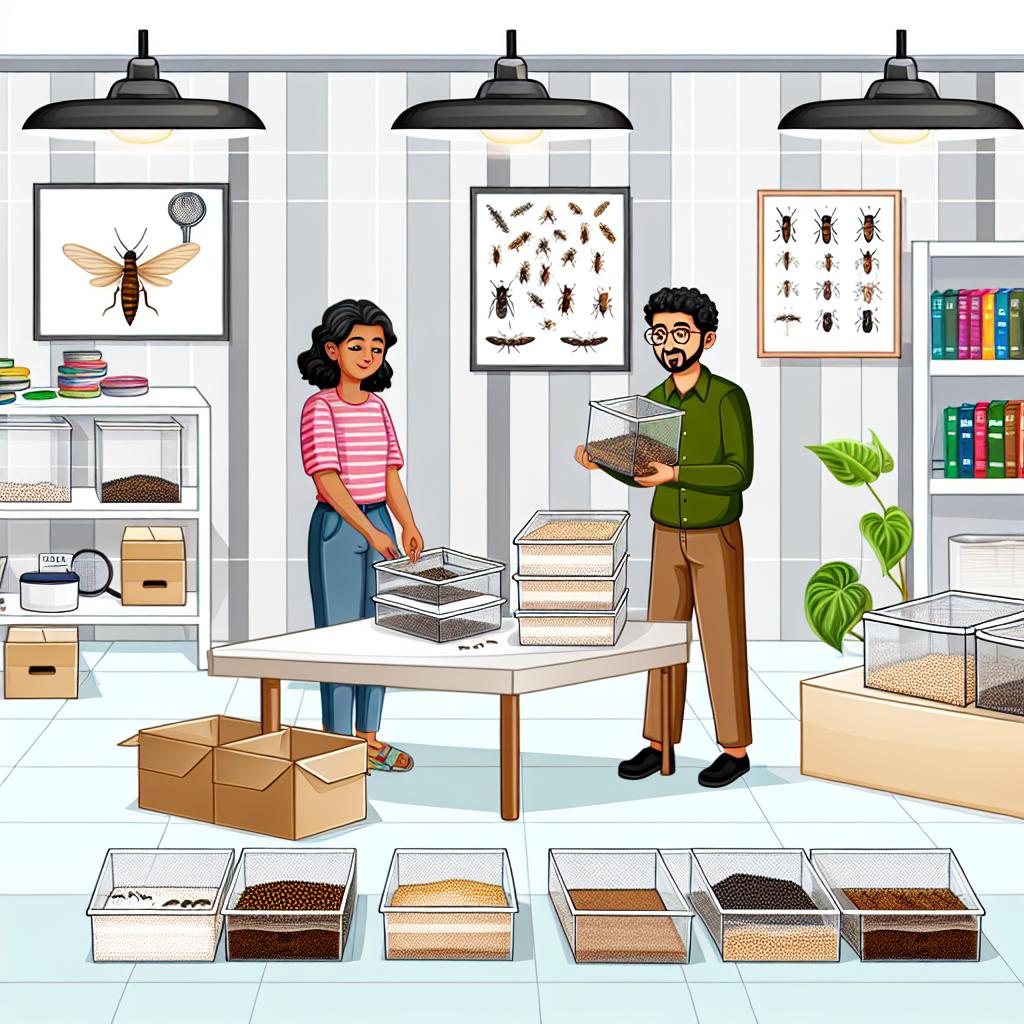Introduction
Starting an insect farm at home can be a sustainable and feasible venture with various benefits, including sourcing protein-rich food for both personal consumption and as feed for pets or livestock. This guide will provide a straightforward approach to initiating an insect farm, considering key aspects such as species selection, habitat setup, and maintenance.
The rise in global demand for sustainable food sources has encouraged many to explore unconventional yet eco-friendly options such as insect farming. Besides being low in resource consumption, insect farming can vastly reduce the carbon footprint associated with traditional animal farming. Producing less greenhouse gas emissions and requiring significantly less water and land, insect farming is notable for its environmental benefits.
Choosing the Right Insect Species
The first step in starting an insect farm is selecting the right species. The choice of species is influenced by several factors, including dietary preferences, climatic adaptability, and the intended use of the insects produced. Commonly farmed insects include mealworms, crickets, and black soldier fly larvae. These insects are chosen due to their nutritional value and ease of farming. Before deciding, consider aspects such as desired use (human consumption or animal feed), availability in your region, and ease of care.
Mealworms
Mealworms are a popular choice for beginners due to their simplicity in rearing and minimal space requirements. They can be used for human consumption or as feed. Their high protein content makes them an excellent meat alternative for vegetarians and an enriching supplement in animal diets. Mealworms are resilient and can thrive in various environments, making them suitable for at-home cultivation.
Crickets
Crickets require a bit more space and care but are an excellent protein source. They are also known for their versatility in diets. Crickets can be processed into flour for baking, added to smoothies, or used as a base ingredient in various dishes. Their chirping sounds might require some getting used to, but many find the musical ambiance they create quite soothing.
Black Soldier Fly Larvae
These larvae are efficient composters and can be used to recycle food waste into high-protein larvae, ideal for feeding poultry and fish. Black Soldier Fly Larvae are not commonly used in human diets but are highly effective in bioconversion of organic waste, transforming it into nutrient-rich fertilizer. Their ability to decompose complex organic materials helps in reducing waste that would otherwise end up in landfills.
Setting Up the Habitat
Creating a suitable environment is crucial for the successful farming of insects. Depending on the species, you will need specific setups. Each species has distinct habitat preferences, from space and light to temperature and humidity requirements that favor their growth and reproduction cycles.
Containers
Use plastic bins or terrariums with proper ventilation for your insects. Ensure your containers are escape-proof yet breathable, with mesh lids being an effective solution. Size your containers based on the volume of insects you intend to cultivate, allowing enough room for growth and activity. Ensuring sufficient space helps to reduce stress and promotes healthy development.
Environmental Conditions
Maintain appropriate temperature and humidity levels based on your chosen insect species. For instance, mealworms thrive at room temperature, while crickets may require heating pads during colder months. Monitoring and adjusting these variables is key to fostering a conducive environment. Many insects are sensitive to their surroundings, and deviations in temperature or humidity can affect their lifecycle and productivity.
Feeding and Nutrition
Insects require a steady diet to thrive. The specific requirements will vary by species, but here are some general guidelines. Providing a balanced diet not only accelerates growth but also impacts the nutritional output of the insects.
Mealworms
Provide them with bran or oats as a base food source, alongside leafy greens for hydration and nutrients. Supplement their diet with occasional fruits and vegetables to enhance their mineral intake. Fresh greens also prevent dehydration and provide essential vitamins.
Crickets
Crickets thrive on a diet of fruits, vegetables, and commercial cricket feed. Ensure they have a water source as well. Water can be supplied through a moist sponge or a shallow dish, preventing drowning. Diverse and nutritious feed influences their growth rates and overall health.
Black Soldier Fly Larvae
They are efficient in consuming organic waste, including fruit scraps and vegetables, making them eco-friendly options. By feeding them your organic waste, you both reduce refuse output and recycle it into valuable biomass. This sustainable approach supports a circular economy.
Maintenance and Harvesting
Regular maintenance is essential for a successful insect farm. Remove dead insects to prevent mold and disease, and clean containers periodically. Proper hygiene practices mitigate risks of contamination and enhance the longevity of your farming setup.
Harvesting will depend on the life cycle of your insects and your intended use for them.
Mealworms
Harvest when they reach the pupae stage, or let them mature into beetles for continuous breeding. The pupae are prime for consumption as they encapsulate the nutritional benefits accrued during their development. For breeding purposes, allowing the pupae to mature ensures a perpetual supply.
Crickets
Gather them when fully mature, ensuring you leave some adults for continued breeding. Timing is important as adult crickets produce more offspring, enabling sustained farming.
Black Soldier Fly Larvae
Harvest larvae before they transition into the pupae stage for optimal nutrition. By doing so, you capture the full protein potential of the larvae before they metamorphosize, preserving their nutritional content for use in animal feeds.
Conclusion
Starting an insect farm at home requires initial setup and consistent maintenance, but it offers numerous rewards, including sustainable protein production and waste reduction. With careful species selection, habitat setup, and regular care, your insect farm can become a valuable addition to your household. Incorporating insects into your farming efforts not only fosters sustainability but also aligns with evolving food security strategies. For further information and resources, consider visiting dedicated insect farming platforms.

